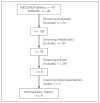Systematic review of complications after intramedullary fixation for displaced midshaft clavicle fractures
- PMID: 23351556
- PMCID: PMC3569477
- DOI: 10.1503/cjs.029511
Systematic review of complications after intramedullary fixation for displaced midshaft clavicle fractures
Abstract
Background: The number of displaced midshaft clavicle fractures treated surgically is increasing, and open reduction and intramedullary fixation is an emerging surgical treatment option. The study quality and scientific levels of published evidence in which possible complications of this treatment are presented vary greatly.
Methods: We performed systematic computer-based searches of EMBASE and PubMed/MEDLINE. Studies included for review reported complications after intramedullary fixation alone or in comparison to either treatment with plate fixation and/or nonoperative treatment. The Level of Evidence rating and Quality Assessment Tool were used to assess the methodological quality of the studies. Included studies were ranked according to their levels of evidence.
Results: Six articles were eligible for inclusion and final quality assessment; 3 studies were graded the highest level of evidence. Major complications like bone-healing problems and deep infections requiring implant removal were reported at a rate no higher than 7%. Reported rates for minor complications, such as wound infection and implant irritation that could be resolved without further surgery, were as high as 31%.
Conclusion: The noted rates for major complications requiring additional surgery were low, but implant-related problems that require additional surgery might present with high prevalence. Owing to routine implant removal, treatment with intramedullary fixation often requires an additional surgical procedure.
Contexte: Le nombre de fractures déplacées de la diaphyse claviculaire traitées chirurgicalement est en hausse et la réduction ouverte avec fixation intramédullaire est une option chirurgicale émergente. La qualité des études et le niveau scientifique des preuves publiées concernant les complications possibles de ce traitement varient beaucoup.
Méthodes: Nous avons procédé à une interrogation systématique des bases de données informatiques EMBASE et PubMed/MEDLINE. Les études retenues pour examen faisaient état de complications après le recours à la fixation intramédullaire seule ou comparée à un traitement par plaque et vis et(ou) un traitement non chirurgical. Nous avons utilisé le classement par niveaux de preuve ou un outil d’évaluation qualitative pour mesurer la qualité méthodologique des études. Les études retenues ont été classées selon leur niveau de preuve.
Résultats: Nous avons retenu 6 articles pour inclusion et évaluation finale de leur qualité; 3 des études présentaient le niveau de preuve le plus élevé. Les complications majeures, notamment des problèmes de cicatrisation de l’os et d’infection profonde nécessitant le retrait de l’implant, ont été signalés selon un taux n’excédant pas 7 %. Les taux de complications mineures rapportées, telles qu’infection de plaie et irritation due à l’implant, qui ont pu rentrer dans l’ordre sans autre chirurgie, se sont élevés à 31 %.
Conclusion: Les taux signalés de complications majeures ayant nécessité une autre chirurgie ont été faibles, mais les problèmes relatifs aux implants ayant nécessité une autre chirurgie pourraient être plus prévalents. Compte tenu du retrait habituel des implants, le traitement par fixation intramédullaire requiert souvent une autre intervention chirurgicale.
Figures

References
-
- Neer CSII. Nonunion of the clavicle. J Am Med Assoc. 1960;172:1006–11. - PubMed
-
- Rowe CR. An atlas of anatomy and treatment of midclavicular fractures. Clin Orthop Relat Res. 1968;58:29–42. - PubMed
-
- Nordqvist A, Petersson C. The incidence of fractures of the clavicle. Clin Orthop Relat Res. 1994;300:127–32. - PubMed
-
- Postacchini F, Gumina S, De Santis P, et al. Epidemiology of clavicle fractures. J Shoulder Elbow Surg. 2002;11:452–6. - PubMed
-
- Chan KY, Jupiter JB, Leffert RD, et al. Clavicle malunion. J Shoulder Elbow Surg. 1999;8:287–90. - PubMed
Publication types
MeSH terms
LinkOut - more resources
Full Text Sources
Other Literature Sources
Medical
